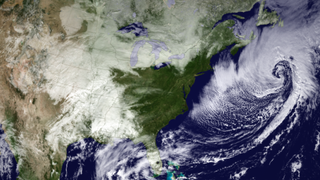
What's Behind the Wild Winter Around the World

Winter in the United States this year has been mild — except for snow-buried Alaska — but around the world, winter is wreaking havoc.
If you're wondering where's winter, don't look to the blizzard in Denver. That weather is more springlike for the area. Instead look to Europe. Cold weather here turned deadly this week. More than 200 people have died during the cold snap, when temperatures fell to as low as minus 36 degrees Fahrenheit (minus 38 degrees Celsius) at one town in Poland. Farther east, in Serbia, snow has trapped 11,000 people in a tiny village.
The European cold snap was triggered by cold air pouring southward into southern and eastern Europe. Heavy snow fell in the mountains and snow similar to that around the Great Lakes covered Istanbul, Turkey. Even more unusual locations had a snowy surprise.
"It is snowing heavily in Rome, Italy. Quite a rare feat!" wrote meteorologists from AccuWeather on Twitter.
Japan, too, is feeling winter's wrath, as heavy snow has killed 56 people and injured more than 750 since November, according to news reports.
Cold weather causes
A sharp dip in the jet stream over Europe caused the recent cold snap. The jet stream is channeling cold air over eastern Europe and Russia, according to the Weather Channel.
Sign up for the Live Science daily newsletter now
Get the world’s most fascinating discoveries delivered straight to your inbox.
In the United States, a return of La Niña, anaturally occurring climate phenomenon featuring cooler-than-average Pacific Ocean temperatures that influences global weather patterns, has pushed the jet stream north, which is partly to blame for Alaska's snowy winter. But in the European region, the effects of La Niña are relatively weak and variable, according to the MET.
In Japan, the massive snowfall is caused by something that Midwesterners can relate to: a cousin tolake-effect snow. In Japan, the phenomenon is called sea-effect snow.
To create sea-effect snow, cold air from Siberia flows southeastward into northeast China and then over the Sea of Japan. When the cold air moves over the comparatively warmer sea, moisture moves into the cold air mass and creates clouds and snow.
Most of this snow falls over the mountains west of Tokyo, one of the snowiest places on Earth. Little snow makes it to the city, on the downwind side, because the air dries as it comes off the mountains.
La Niña also has a hand in Japan's snow. La Niña's resurgence has warmed the waters near Southeast Asia, which makes the sea-effect snow even greater by creating moister air.
Weekend outlook
The latest forecasts show a sharp dip in the jet stream over Europe, which should turn into a low-pressure system over the central Mediterranean and Adriatic Sea this weekend. This would allow the cold to linger into at least early next week.
"Expect the cold to persist, particularly in eastern and southern Europe through the weekend into at least the first half of next week!" wrote Jonathan Erdman, senior meteorologist at the Weather Channel. [The Coldest Places on Earth]
In the UK, winter weather will continue into the weekend, according to Paul Gundersen, deputy chief forecaster at the Met Office, the UK's weather service.
"As this front moves in from the west it will come up against cold air and we're likely to see a mixture of rain, sleet and snow across the UK," Gundersen said in the MET's forecast.
Snow showers are expected along parts of the eastern coastline this weekend, but most places will continue to see bright, dry and cold conditions, according to the MET forecast.
Japan's sea-effect snow machine should quiet down by the weekend, as a weak high-pressure system moves into the region. This would turn off cold air flowing over the Sea of Japan. But the break in the snow might not last long as the snow machine could turn back on by late next week, according to the Weather Channel forecast.
You can follow OurAmazingPlanet staff writer Brett Israel on Twitter: @btisrael. Follow OurAmazingPlanet for the latest in Earth science and exploration news on Twitter @OAPlanet and on Facebook.
Most Popular

